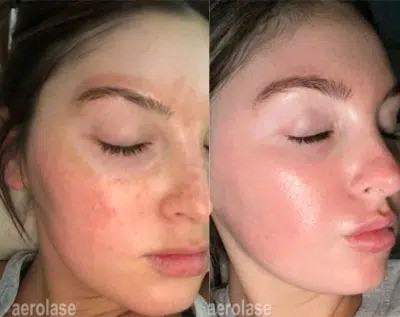Laser treatments for melasma

Melasma, a common skin condition characterized by hyperpigmentation and dark patches on the face, can be challenging to manage. While topical treatments and skincare regimens are often recommended, some individuals may seek more advanced solutions to address melasma effectively. In recent years, Aerolase laser skin treatments have emerged as a promising option for treating melasma. In this comprehensive guide, we’ll explore how Aerolase laser technology works, its effectiveness in treating melasma, what to expect during treatment sessions, and why it’s gaining popularity among dermatologists and patients alike.
Understanding Melasma and its Challenges
Melasma is a chronic skin condition characterized by dark patches or hyperpigmentation, typically occurring on the face, particularly the cheeks, forehead, nose, and upper lip. It is more prevalent in women and is often triggered or exacerbated by hormonal changes, sun exposure, and certain medications. Melasma can be challenging to treat, as it tends to recur even after successful treatment and may worsen with sun exposure.
Introduction to Aerolase Laser Skin Treatments
Aerolase laser technology is a state-of-the-art approach to treating various skin conditions, including melasma. Unlike traditional lasers, which can be harsh and cause discomfort, Aerolase lasers deliver gentle yet powerful energy pulses to target melanin in the skin without causing damage to surrounding tissues. This makes Aerolase laser treatments well-suited for addressing melasma, as they can effectively break down excess pigment while minimizing the risk of side effects such as post-inflammatory hyperpigmentation.
How Aerolase Laser Treatments Work for Melasma
Aerolase laser treatments work by targeting melanin, the pigment responsible for dark spots and hyperpigmentation in melasma-affected skin. The laser energy is absorbed by the melanin, causing it to heat up and break apart into smaller particles. Over time, the body’s natural healing processes eliminate these fragmented pigment particles, resulting in a more even skin tone and reduction in melasma-related discoloration.
Effectiveness of Aerolase Laser Treatments for Melasma
Numerous studies and clinical trials have demonstrated the effectiveness of Aerolase laser treatments in improving melasma. Patients typically experience significant lightening of dark patches and a more uniform complexion after a series of treatment sessions. Additionally, Aerolase lasers are safe for all skin types and tones, making them suitable for a wide range of patients with melasma.
What to Expect During Aerolase Laser Treatment Sessions
Before undergoing Aerolase laser treatment for melasma, patients will have a consultation with a dermatologist or skincare professional to assess their skin condition and treatment goals. During the treatment session, the patient’s skin is cleansed, and protective eyewear is provided to shield the eyes from the laser light.
The Aerolase laser device is then applied to the skin, emitting quick pulses of laser energy to target melasma-affected areas. Patients may feel a mild tingling or warmth during the procedure, but discomfort is minimal, thanks to the gentle and precise nature of Aerolase lasers. Treatment sessions typically last between 20 to 30 minutes, depending on the size of the treatment area and the severity of the melasma.
Recovery and Results
After Aerolase laser treatment for melasma, patients may experience mild redness or swelling, similar to a sunburn, which usually subsides within a few hours. It’s essential to protect the skin from sun exposure and follow any post-treatment skincare recommendations provided by the dermatologist to optimize results and minimize the risk of complications.
Most patients notice gradual improvements in their melasma-related hyperpigmentation over the following weeks and months as the treated areas lighten and blend with the surrounding skin. A series of treatment sessions spaced several weeks apart may be recommended to achieve optimal results, with maintenance sessions scheduled as needed to sustain the benefits of Aerolase laser therapy.
Why Aerolase Laser Treatments Are Gaining Popularity for Melasma Treatment
Aerolase laser treatments are gaining popularity among dermatologists and patients for several reasons:
Efficiency: Aerolase lasers deliver targeted energy pulses to break down excess pigment quickly and effectively, resulting in visible improvements in melasma-related hyperpigmentation.
Safety: Aerolase lasers are safe for all skin types and tones, minimizing the risk of adverse effects such as post-inflammatory hyperpigmentation, which can occur with other laser treatments.
Comfort: Aerolase lasers offer a comfortable treatment experience, with minimal discomfort and downtime, allowing patients to resume their daily activities immediately after treatment.
Versatility: In addition to treating melasma, Aerolase lasers can address other skin concerns, such as acne, rosacea, and fine lines and wrinkles, making them a versatile option for comprehensive skin rejuvenation.
Aerolase laser skin treatments offer a safe, effective, and non-invasive solution for improving melasma-related hyperpigmentation and achieving a more even complexion. With their gentle yet powerful technology and minimal downtime, Aerolase lasers are becoming a preferred choice for dermatologists and patients seeking advanced solutions for melasma management. If you’re struggling with melasma, consider consulting with a qualified skincare professional to learn more about how Aerolase laser treatments can help you achieve clearer, more radiant skin.
Categories
Categories
Get Updates:
Lightstim post microneedlinghttps://t.co/OY5xpFFjgs pic.twitter.com/57WMJwr2LD
— Miami Aesthetic Institute (@Miami_Aesthetic) January 8, 2020


















